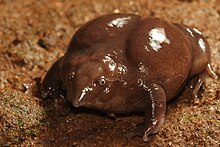| Sooglossoidea | |
|---|---|

| |
| Thomasset's Seychelles frog (Sooglossus thomasseti) | |

| |
| Purple frog (Nasikabatrachus sahyadrensis) | |
|
Scientific classification
| |
| Domain: | Eukaryota |
| Kingdom: | Animalia |
| Phylum: | Chordata |
| Class: | Amphibia |
| Order: | Anura |
| Suborder: | Neobatrachia |
| Superfamily: |
Sooglossoidea Noble, 1931 |
| Families | |
Sooglossoidea is a superfamily of frogs. It contains only two highly divergent families consisting of three genera with two species each, one family being found in southwestern India and the other in the Seychelles. [1]
The Sooglossoidea are an ancient division of the Neobatrachia; phylogenetic evidence indicates that they diverged from the rest of the Neobatrachia during the Early Cretaceous, about 125 million years ago, after colonizing Insular India from Africa. One family, the Nasikabatrachidae, remained in India; the other, Sooglossidae, was isolated on the Seychelles Microcontinent (which later turned into an island chain) after it split from India. Both families are thought to have diverged around the Cretaceous-Paleogene boundary. [2] [3]
Their exact phylogenetic relationships are disputed; previous studies found them to be the second-most basal member of the Neobatrachia, being sister to all other members of the group aside from Heleophrynidae, but more recent studies support them being significantly more derived and being the sister group to the Ranoidea. [2] [4]
Sooglossoidea contains the following families: [5] [6]
- Nasikabatrachidae Biju and Bossuyt, 2003 - purple pignosed frogs (2 species)
- Sooglossidae Noble, 1931 - Seychelles frogs (4 species)
Some studies suggest that the Late Cretaceous frog Indobatrachus, known from numerous fossil specimens from India, may also represent a member of the Sooglossoidea. [3]
- ^ Dubois, Alain (2005). "Amphibia Mundi. 1.1. An ergotaxonomy of recent amphibians". Alytes. 23 (1–2): 1–24. INIST 16956204 ProQuest 1319774213.
- ^ a b Feng, Yan-Jie; Blackburn, David C.; Liang, Dan; Hillis, David M.; Wake, David B.; Cannatella, David C.; Zhang, Peng (2017-07-18). "Phylogenomics reveals rapid, simultaneous diversification of three major clades of Gondwanan frogs at the Cretaceous–Paleogene boundary". Proceedings of the National Academy of Sciences. 114 (29): E5864–E5870. Bibcode: 2017PNAS..114E5864F. doi: 10.1073/pnas.1704632114. ISSN 0027-8424. PMC 5530686. PMID 28673970.
- ^ a b Biju, S. D.; Bossuyt, F. (2003). "New frog family from India reveals an ancient biogeographical link with the Seychelles". Nature. 425 (6959): 711–714. Bibcode: 2003Natur.425..711B. doi: 10.1038/nature02019. PMID 14562102. S2CID 4425593.
- ^ Alexander Pyron, R.; Wiens, John J. (2011-11-01). "A large-scale phylogeny of Amphibia including over 2800 species, and a revised classification of extant frogs, salamanders, and caecilians". Molecular Phylogenetics and Evolution. 61 (2): 543–583. doi: 10.1016/j.ympev.2011.06.012. ISSN 1055-7903. PMID 21723399.
- ^ "Sooglossidae Noble, 1931 | Amphibian Species of the World". amphibiansoftheworld.amnh.org. Retrieved 2022-09-13.
- ^ "Nasikabatrachidae Biju and Bossuyt, 2003 | Amphibian Species of the World". amphibiansoftheworld.amnh.org. Retrieved 2022-09-13.
| Sooglossoidea | |
|---|---|

| |
| Thomasset's Seychelles frog (Sooglossus thomasseti) | |

| |
| Purple frog (Nasikabatrachus sahyadrensis) | |
|
Scientific classification
| |
| Domain: | Eukaryota |
| Kingdom: | Animalia |
| Phylum: | Chordata |
| Class: | Amphibia |
| Order: | Anura |
| Suborder: | Neobatrachia |
| Superfamily: |
Sooglossoidea Noble, 1931 |
| Families | |
Sooglossoidea is a superfamily of frogs. It contains only two highly divergent families consisting of three genera with two species each, one family being found in southwestern India and the other in the Seychelles. [1]
The Sooglossoidea are an ancient division of the Neobatrachia; phylogenetic evidence indicates that they diverged from the rest of the Neobatrachia during the Early Cretaceous, about 125 million years ago, after colonizing Insular India from Africa. One family, the Nasikabatrachidae, remained in India; the other, Sooglossidae, was isolated on the Seychelles Microcontinent (which later turned into an island chain) after it split from India. Both families are thought to have diverged around the Cretaceous-Paleogene boundary. [2] [3]
Their exact phylogenetic relationships are disputed; previous studies found them to be the second-most basal member of the Neobatrachia, being sister to all other members of the group aside from Heleophrynidae, but more recent studies support them being significantly more derived and being the sister group to the Ranoidea. [2] [4]
Sooglossoidea contains the following families: [5] [6]
- Nasikabatrachidae Biju and Bossuyt, 2003 - purple pignosed frogs (2 species)
- Sooglossidae Noble, 1931 - Seychelles frogs (4 species)
Some studies suggest that the Late Cretaceous frog Indobatrachus, known from numerous fossil specimens from India, may also represent a member of the Sooglossoidea. [3]
- ^ Dubois, Alain (2005). "Amphibia Mundi. 1.1. An ergotaxonomy of recent amphibians". Alytes. 23 (1–2): 1–24. INIST 16956204 ProQuest 1319774213.
- ^ a b Feng, Yan-Jie; Blackburn, David C.; Liang, Dan; Hillis, David M.; Wake, David B.; Cannatella, David C.; Zhang, Peng (2017-07-18). "Phylogenomics reveals rapid, simultaneous diversification of three major clades of Gondwanan frogs at the Cretaceous–Paleogene boundary". Proceedings of the National Academy of Sciences. 114 (29): E5864–E5870. Bibcode: 2017PNAS..114E5864F. doi: 10.1073/pnas.1704632114. ISSN 0027-8424. PMC 5530686. PMID 28673970.
- ^ a b Biju, S. D.; Bossuyt, F. (2003). "New frog family from India reveals an ancient biogeographical link with the Seychelles". Nature. 425 (6959): 711–714. Bibcode: 2003Natur.425..711B. doi: 10.1038/nature02019. PMID 14562102. S2CID 4425593.
- ^ Alexander Pyron, R.; Wiens, John J. (2011-11-01). "A large-scale phylogeny of Amphibia including over 2800 species, and a revised classification of extant frogs, salamanders, and caecilians". Molecular Phylogenetics and Evolution. 61 (2): 543–583. doi: 10.1016/j.ympev.2011.06.012. ISSN 1055-7903. PMID 21723399.
- ^ "Sooglossidae Noble, 1931 | Amphibian Species of the World". amphibiansoftheworld.amnh.org. Retrieved 2022-09-13.
- ^ "Nasikabatrachidae Biju and Bossuyt, 2003 | Amphibian Species of the World". amphibiansoftheworld.amnh.org. Retrieved 2022-09-13.